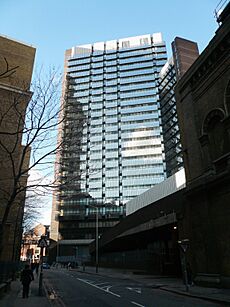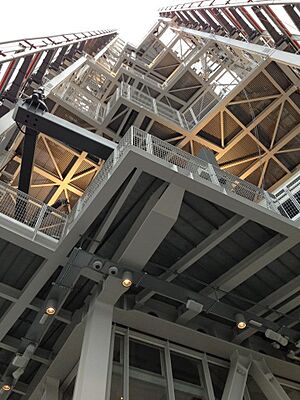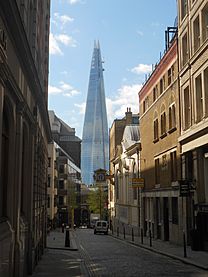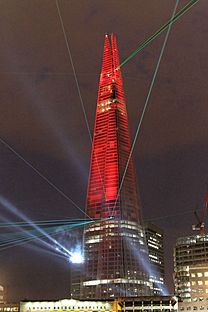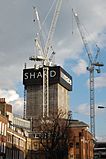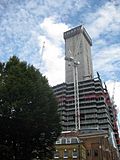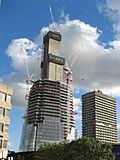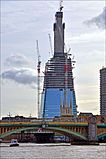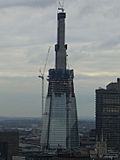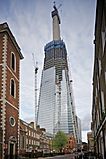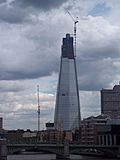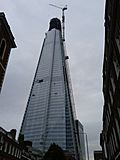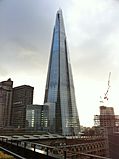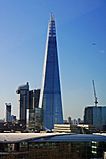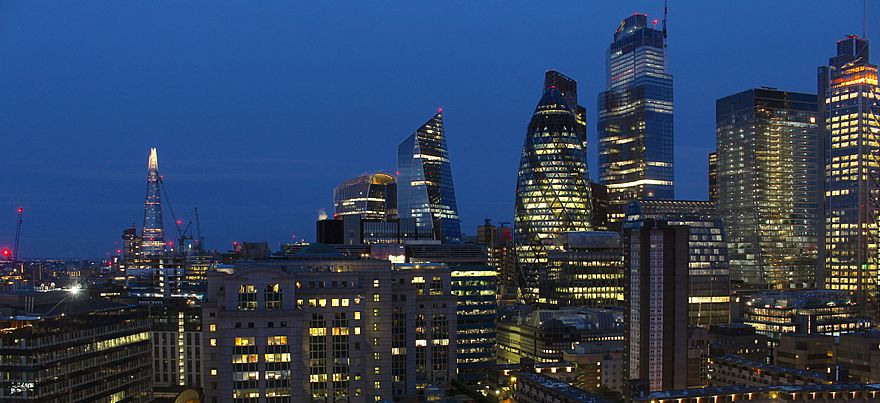The Shard facts for kids
Quick facts for kids The Shard |
|
|---|---|
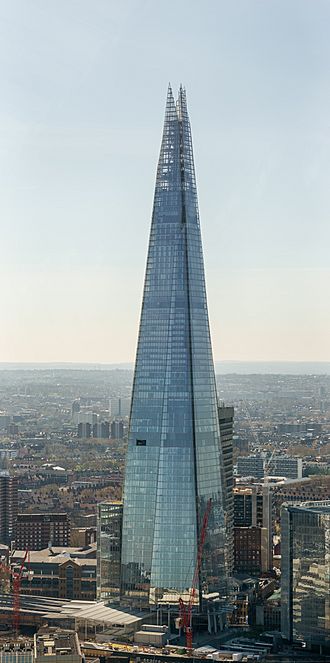
The Shard in April 2015
|
|
| Alternative names | Shard London Bridge |
| Record height | |
| Tallest in Europe from 2011 to 2012 | |
| Preceded by | City of Capitals |
| Surpassed by | Mercury City Tower |
| General information | |
| Status | Complete |
| Location | London, England, UK |
| Coordinates | 51°30′16″N 0°05′11″W / 51.5045°N 0.0865°W |
| Construction started | 16 March 2009 |
| Completed | 5 July 2012 |
| Opening | 1 February 2013 |
| Cost | ~£435,023,452 (contract cost only) |
| Owner | State of Qatar (95%) Sellar Property Group (5%) |
| Height | |
| Architectural | 309.6 m (1,016 ft) |
| Observatory | 244 m (801 ft) |
| Technical details | |
| Floor count | 95 (72 habitable) |
| Floor area | 398,490 m2 (4,289,300 sq ft) |
| Lifts/elevators | 36 |
| Design and construction | |
| Architect | Renzo Piano |
| Developer | Sellar Property Group |
| Structural engineer | WSP Global (structural engineers), Robert Bird Group (concrete temporary works), Ischebeck Titan on most floors 40+ (concrete support) |
| Services engineer | Arup |
| Main contractor | Mace |
The Shard is a very tall building in London, England. It is also known as the Shard London Bridge. An Italian architect named Renzo Piano designed it. The Shard has 72 floors and is part of a bigger area called The Shard Quarter.
It is 309.6 metres (1,016 feet) high. This makes The Shard the tallest building in the United Kingdom. It is also the seventh-tallest building in Europe. The Shard is the second-tallest stand-alone structure in the UK. Only the Emley Moor transmitting station is taller. The Shard was built where an older office building, Southwark Towers, used to be.
Building The Shard started in March 2009. It reached its full height on 30 March 2012. The building officially opened on 5 July 2012. Its viewing deck, The View from The Shard, opened to the public on 1 February 2013. The Shard looks like a glass pyramid. It has a viewing gallery and an open-air deck on the 72nd floor. This is at a height of 244 metres (801 ft). The Shard is mostly owned by the State of Qatar (95%).
Contents
Building The Shard
Planning the Project
In 1998, a London businessman named Irvine Sellar wanted to rebuild the Southwark Towers. This old building was from the 1970s. The UK government wanted new tall buildings near major transport places. So, Sellar decided to build a new one.
In 2000, Sellar met the Italian architect Renzo Piano. Piano did not like typical tall buildings. He drew a spire-like shape on a menu, like something rising from the River Thames. This drawing became the idea for The Shard.
In 2002, the government had to review the plans for The Shard. Some groups did not like the idea. These included the Commission for Architecture and the Built Environment and English Heritage. They thought it would harm London's historic look.
The review happened in 2003. On 19 November 2003, the government approved the plans. They said that only very well-designed skyscrapers would be allowed. They believed The Shard's design was of the highest quality.
Sellar and his partners got money in 2006. This helped them pay for costs and buy out the old building's tenants, PricewaterhouseCoopers. The site was empty a year later.
In September 2007, work began to take down Southwark Towers. But then, money problems around the world made people worry about The Shard's future.
In November 2007, the company Mace was chosen to build The Shard. The cost was set at £350 million. But by October 2008, the price went up to almost £435 million.
By April 2008, Southwark Towers was being taken down. By early 2009, it was gone. Then, work started to prepare the site for The Shard.
Getting the Money
At the end of 2007, money problems worldwide made people doubt if The Shard would be built. But in January 2008, Sellar announced good news. A group of investors from Qatar agreed to provide money. They bought 80% of the project.
This group included Qatar National Bank and other Qatari companies. They promised to provide the first part of the money. This allowed building to start. In 2009, the State of Qatar bought out the private Qatari investors. Now, The Shard is mostly owned by the State of Qatar and Sellar.
Design of The Shard
Renzo Piano designed The Shard to look like a spire rising from the River Thames. He was inspired by nearby railway lines and old paintings of London's church spires. He also thought of the tall masts of sailing ships.
Some people from English Heritage did not like the design. They said it would be "a shard of glass through the heart of historic London." This is how the building got its name, The Shard. Piano believed the tall, slender shape would be a good addition to London's skyline. He thought it would look delicate, like old church steeples.
The building uses special angled glass panels. These are meant to reflect sunlight and the sky. This means The Shard's look changes with the weather and seasons. The building has 11,000 panes of glass. Their total area is like almost eight Wembley football pitches!
The Shard was built to save energy. It has a special plant that makes electricity and heat from natural gas. This heat is then used to provide hot water for the building.
After the September 11 attacks in 2001, architects thought more about how to design tall buildings to be safe. The Shard's early plans were changed to make it very strong. It is designed to stay stable even in very difficult conditions.
In 2014, The Shard won the Emporis Skyscraper Award. This award is for buildings over 100 m (328 ft) completed in the past year. The judges called it "a skyscraper that is recognized immediately." They said it was "London's new emblem."
What's Inside The Shard?
The Shard has many different uses. It has offices, restaurants, a hotel, and homes. It also has the highest viewing gallery in the UK.
| Floors | What's There |
|---|---|
| 73–95 | Spire (top pointy part) |
| 68–72 | The View from The Shard (place to see the city) |
| 53–65 | Homes |
| 34–52 | Shangri-La Hotel |
| 33 | Hutong (restaurant) |
| 32 | Oblix (restaurant) |
| 31 | Aqua Shard (restaurant) |
| 28 | South Hook Gas (offices) |
| 27 | Arma Partners / Campari Group (offices) |
| 26 | CoStar Group (offices) |
| 24–25 | The Office Group (offices) |
| 23 | Foresight Group (offices) |
| 22 | Khazanah / Jellyfish (offices) |
| 20–21 | Kraft Heinz (offices) |
| 19 | Medical Protection Society (offices) |
| 18 | Gallup / Foresight Group (offices) |
| 17 | Warwick Business School / Sage Group (offices) |
| 16 | Al Jazeera English (TV studio) |
| 15 | Mathys & Squire / Arcapita / Xio Partners / Fulcrum Chambers (offices) |
| 14 | Duff & Phelps (offices) |
| 13 | Warwick Business School / Duff & Phelps / Sage Group (offices) |
| 12 | Mitie (offices) |
| 11 | Dods Group / Matches Fashion (offices) |
| 10 | Real Estate Management (UK) Limited / Robert Half / Protiviti (offices) |
| 9 | IO Oil and Gas / Sapphire Systems / Siteimprove (offices) |
| 8 | Greenberg Traurig / Matches Fashion (offices) |
| 7 | Tiffany & Co. / Matches Fashion (offices) |
| 4–6 | Clinic (HCA Healthcare at the Shard) |
| 3 | Shard Quarter Management Suite (offices) |
| 2 | Office Reception |
| Ground | Hotel, restaurant and observatory entrances |
Sources: The-Shard.com and The-Shard.com and Billionpoints.de.
How The Shard Was Built
Builders used new engineering methods for The Shard. One method was "top-down construction." This means they dug the foundations while building the core of the building upwards. This was the first time this was done in the UK.
In February 2009, cranes arrived at the site. By March, they started putting steel beams into the ground. Full construction began on 16 March 2009. Five cranes were used to build The Shard. Four of them "jumped" higher as the tower grew.
By March 2010, the concrete core was rising about 3 m (10 ft) each day. By mid-June, it reached the 33rd floor. This was almost as tall as Guy's Hospital. By mid-November 2010, the core reached the 68th floor. The steel frame reached the 40th floor. Glass was put on about a third of the building. In late November, The Shard became Britain's tallest building. It passed One Canada Square.
The concrete core reached its highest point, the 72nd floor, in early 2011. It was 244 m (801 ft) tall. In January 2011, hydraulic screens were put in place. These helped form the concrete floors for the hotel and apartments. By the end of February 2011, a new concrete floor was being poured almost every week.
During this time, a fox was found living at the top of the unfinished skyscraper! Workers named the fox Romeo. He likely got in through the stairs. He ate food scraps left by the builders. The fox was later caught and taken to an animal center.
By August 2011, more than half of the building's outside was covered in glass. The concrete floors reached the 67th floor. By mid-August, the core box was removed. By 19 September 2011, the steel frame was almost as tall as the completed core.
On 24 September, the tallest crane ever built in Britain was put up. It was used to install the skyscraper's top spire. The spire was built in pieces and tested in Yorkshire first. By late December 2011, The Shard became the tallest building in the European Union. It passed the Commerzbank Tower in Germany.
The steel structure of The Shard was finished on 30 March 2012. Its 66-metre (217 ft) spire, weighing 500 tonnes, was lifted into place. The steel structure reached 308.7 m (1,013 ft). The last 516 glass panes were added soon after. This brought the tower to its full height of 309.6 m (1,016 ft).
The Shard was officially opened on 5 July 2012. The Prime Minister of Qatar and Prince Andrew, Duke of York attended the ceremony. The building was fully finished in November 2012.
Building Progress Pictures
How Tall is The Shard?
The Shard is 309.6 metres (1,016 ft) tall at its highest point. Its steel structure reaches 308.5 metres (1,012 ft). In December 2011, The Shard became the tallest building in the European Union. On 30 March 2012, it became the tallest completed building in Europe.
It is taller than Frankfurt's Commerzbank Tower, which was the tallest from 1997 to 2005. It was also taller than three skyscrapers in Moscow for a while. However, in November 2012, the 339-metre (1,112 ft) Mercury City Tower in Moscow became taller. In February 2021, the 310-meter (1,017 ft) Varso Tower in Warsaw, Poland, became the tallest European building outside Russia.
The Shard is the second-tallest stand-alone structure in the UK. The 330-metre (1,083 ft) concrete tower at Emley Moor is taller. Another planned skyscraper in London, called The Pinnacle, was supposed to be as tall as The Shard. But its height was lowered to 287.9 metres (945 ft) because of concerns from the Civil Aviation Authority. The Shard is taller than all natural hills in London and nearby areas.
Who Uses The Shard?
The Shard has 26 floors of offices. These are used by 32 companies from 10 different business types. There are also three restaurants: Aqua Shard, Oblix, and Hutong. A five-star hotel, the Shangri-La Hotel, is also in The Shard. It has 10 residential apartments and the UK's highest viewing gallery, The View from The Shard.
In February 2013, news reports said that companies were talking about renting office space in The Shard. These included financial experts Duff & Phelps and the South Hook Liquefied Natural Gas Company.
The fourth, fifth, and sixth floors of The Shard have a clinic. This is part of London Bridge Hospital. The 31st, 32nd, and 33rd floors have the three restaurants. The Shangri-La Hotel is on floors 34–52. It opened on 6 May 2014. In March 2014, Mathys & Squire became the first law firm to move into the building.
In May 2014, Foresight Group, an investment company, moved its main UK office to the 17th floor. In June 2015, Warwick Business School opened its new base in The Shard. The Mayor of London, Boris Johnson, officially opened it. It has lecture halls and study rooms for students.
In July 2013, the Qatari TV company Al Jazeera Media Network said it would open a new TV studio in The Shard. Al Jazeera English moved in on 13 September 2014. Their first live broadcast from the building was on 10 November 2014. This place now handles all main operations for Al Jazeera's channels in London. It is their second-biggest center after their main one in Qatar.
In January 2015, more companies were announced as tenants. These included IO Oil & Gas Consulting, Gallup, and The Office Group. In May 2015, the American company Robert Half International moved some of its offices into The Shard. They rented 20,000 square feet (1,900 m2) of space on the tenth floor. In August 2015, the law firm Greenberg Traurig announced it would open offices on the eighth floor.
Matches Fashion rented a large space in January 2016. Six months later, they expanded their office in The Shard. In March 2016, Jellyfish, a marketing company, rented office space on the 22nd floor. A month later, Dods Group, a publishing company, rented space on Level 11. In December, Kraft Heinz moved their European headquarters to The Shard. They took 38,000 square feet (3,500 m2) on Levels 20 & 21.
The Shard's offices were fully rented out by October 2017. This happened after Mitie and existing companies like Foresight Group and Warwick Business School rented more space.
Adventures at The Shard
In December 2011, a group of explorers called Place Hackers got past security. They climbed to the top of The Shard while it was still being built. They even climbed one of the tallest cranes. They later shared photos of London from the top. One member, Bradley Garrett, said that over 20 urban explorers had climbed the building during its construction.
People who do BASE jumping reportedly jumped from The Shard more than a dozen times between 2009 and 2012. One person filmed a jump with a camera on his helmet. The highest jump was said to be from 260 metres (850 ft). Another person BASE jumped from The Shard in March 2016.
On 3 September 2012, a team of 40 people abseiled down from the tower's 87th floor. This included Prince Andrew, Duke of York. They did this to raise money for charities. In November 2012, the French urban climber Alain Robert was seen at the building. The Shard's owners then got a court order to stop him from climbing the building.
On 11 July 2013, six female Greenpeace volunteers climbed The Shard. They put up a flag to protest against oil drilling in the Arctic by Royal Dutch Shell. The women said they were experienced climbers. The Shard's staff closed the viewing deck. They also gave the women safety advice during their climb. After climbing for 16 hours, the six women were arrested by police.
The Shard in Pop Culture
- The Shard appears in the 2012 short film The Snowman and The Snowdog and its computer game.
- It plays a big part in the 2013 Doctor Who episode "The Bells of Saint John". It is the main bad guy's headquarters. The Doctor rode a special motorbike up the side of the building to get inside.
- The Shard is seen in the final scene of the 2019 movie Spider-Man: Far From Home. It is where Nick Fury and Maria Hill watch the battle between Spider-Man and Mysterio.
- The Pokémon Duraludon from Pokémon Sword and Shield is based on The Shard.
- The Shard appears in the 2020 video game Watch Dogs: Legion. It is called 'Nexus Tower' in the game.
- The Shard is shown in the 2022 music video for the Machine Gun Kelly song "Maybe".
See also
 In Spanish: The Shard para niños
In Spanish: The Shard para niños
Similar Buildings


